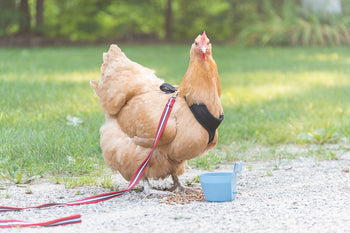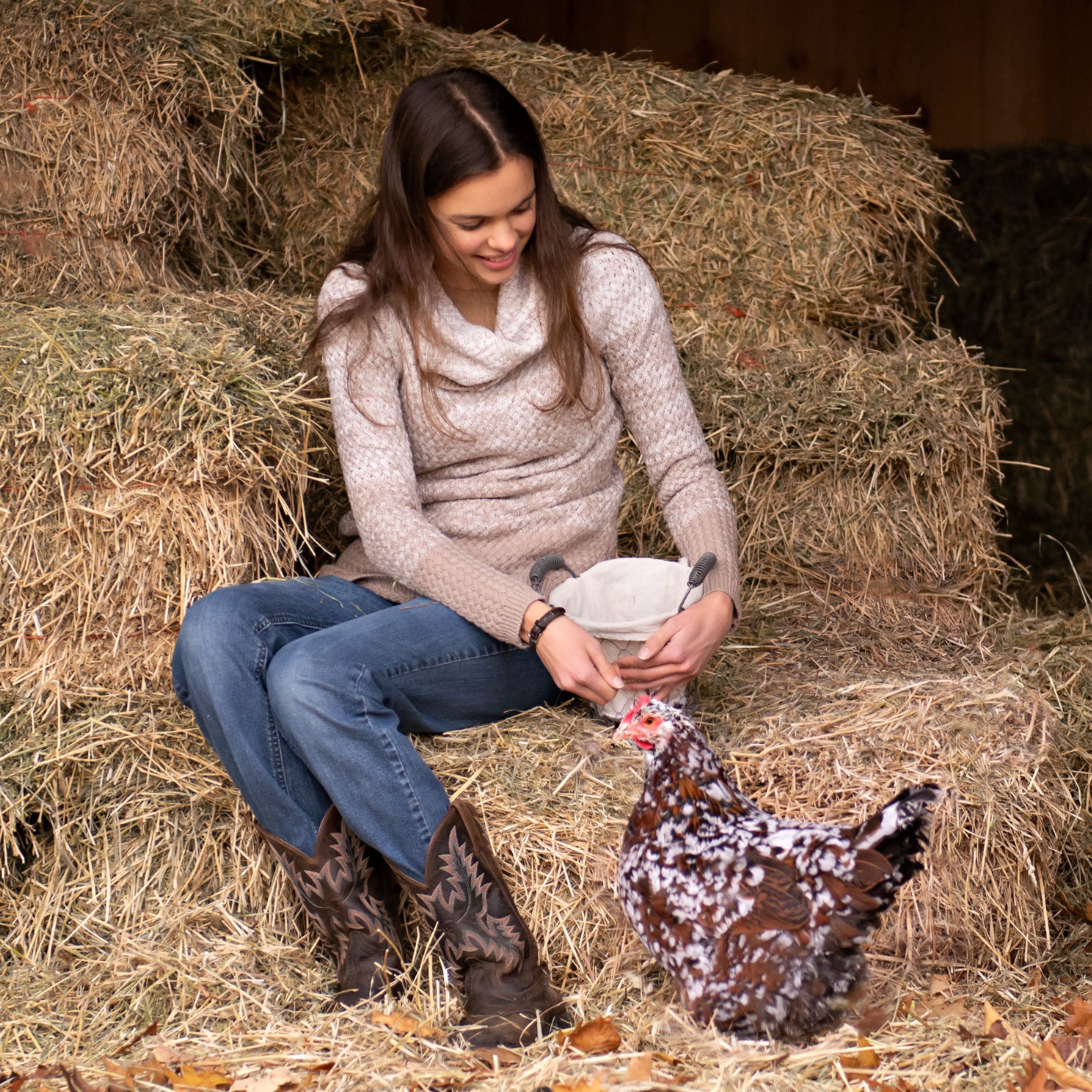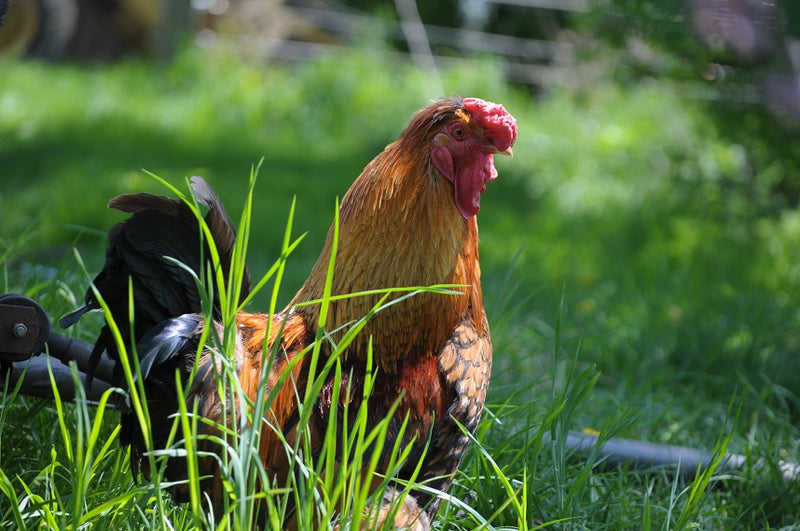The idea of taking your chicken on a walk, just like you would a dog, is growing in popularity as more urban chicken raisers are looking for safe and practical ways to get their hens some exercise. Plus, our backyard chickens quickly become beloved pets and it’s fun to think that we can train them to wear a harness and walk on a leash. Whether you have a pet hen who will let you do anything with her, or you are looking for a safe way to exercise your small urban flock, learning how a chicken harness functions can open doors for an adventurous and new experience!

What is a Chicken Harness? Understanding the Concept
A chicken harness is very similar to any other pet harness. The harness usually has a loop that goes over the chicken’s head and the rest of the harness straps around the chicken’s body, going under the chicken’s wings. Most harnesses are made from breathable, mesh material that has some flexibility to make it comfortable for a chicken to wear. The soft, mesh material also doesn’t damage a chicken’s feathers and makes the harness easy to wash if it gets soiled.
A chicken harness works much like a harness for a dog. It doesn’t put pressure around the chicken’s neck. Instead, you clip a leash to a ring that is attached to the back part of the harness. Since the harness fastens around the chicken’s abdomen, any pressure that gets applied when the leash is pulled taunt is only felt around the chicken’s body.
Chicken harnesses usually come in several different sizes. The most common sizes are bantam or small size, standard size, and large or rooster size. Make sure you choose harness size that is the correct fit for your chicken. A harness that is too big makes it easy for the chicken to slip out of. A harness that is too small puts too much pressure around a chicken’s neck and abdomen.
In addition to a chicken harness, you should also get a 6-foot leash to attach to the harness. Both the leash and the leash clip should be lightweight so that they don’t weigh down a small chicken.
Pros and Cons of Using Chicken Harnesses
Benefits: Training your chicken to wear a harness and walk on a leash is actually not just a fun training trick. Chicken harnesses can provide several benefits for you and your flock. It allows you to take your chickens out for outdoor exercise even in high predation areas or in areas where they can’t free-range. The harness keeps them safely near you while still allowing them to explore and get some exercise.
Training your chicken to wear a chicken harness can open up numerous outdoor activities. Obstacle courses, short hikes, or even a ride in a bicycle basket can be made safer and more enjoyable when your chicken is wearing a chicken harness.
Chicken harnesses are also popular tools to use for therapy chickens. Chickens who are docile and friendly can make good therapy chickens. Many folks take their therapy chickens to special events or nursing homes to share the joy of chickens with others! During any social excursion, whether it be to the local pet store or to a nursing home, a chicken harness makes it easier to manage your chicken when out in public.
Besides, who doesn’t like to show off that their favorite hen knows how to walk on a leash!?
Drawbacks & Challenges: Teaching a chicken to wear a chicken harness does not come without its drawbacks and challenges. First off, most chickens will probably take longer to train to a harness and leash than cats or dogs. Chickens are prey animals, so wearing something that restricts their freedom to move can make them feel more vulnerable. However, establishing a good trusting relationship with your hen can make training her to harness and leash much easier.
You also need to make sure you use the proper size of chicken harness for your chicken. An ill-fitting harness can cause stress for both you and your hen. You want to make sure the harness is snug enough that your hen can’t escape from the harness. However, it should not restrict the hen’s breathing or apply too much pressure around her abdomen or neck. The more comfortable the harness is for a chicken to wear, the less stress the harness will cause for the hen.
Also make sure the harness does not cause any feather damage. The harness material should be soft and somewhat flexible so that it doesn’t chafe or tear a hen’s feathers. Don’t allow your chicken to wear a harness when she is not supervised. The harness should be used for when you and your chicken go on excursions and adventures together, not for all-day wearing. The harness could get caught or hooked on objects in the chicken coop, chicken enclosure, or yard when a hen is going about her usual activities.
Can All Chickens Be Leashed? Considering Your Chicken’s Personality
Some chickens just don’t adapt to wearing a harness or walking on a leash very well. The key to success when training your chickens to wear a harness is to consider your chicken’s personality and the relationship you have with your chicken or flock.
A chicken who is calm, friendly, and docile will adapt to wearing a harness much faster than a hen who is active, flighty, and independent. If the hen is already used to being handled and trusts that you won't harm her, she will be more willing to wear the harness and learn to walk on a leash.
In general, large chicken breeds like Buff Opringtons or Cochins, are more laid-back than light chicken breeds, such as Leghorns or Minorcas. While breed does play a role in a chicken’s personality, any chicken can become tame and docile if they are handled frequently and treated with kindness and respect. Handling your chickens starting when they are very young and harness training them at a young age will make the process go much smoother and quicker.
Both hens and roosters can be trained to wear a chicken harness and walk on a leash. When working with a rooster, be sure to have a strong relationship with him and work with him so that he learns to trust you. Roosters with aggressive or assertive personalities will not take well to harness training and can be dangerous to you.
When choosing a chicken to harness train, choose a chicken who is laid-back, friendly, calm, and used to being handled. It can also be beneficial if the chicken is very food-motivated — that way you can use treats as a motivating reward during harness training!
Some of the easiest chicken breeds to harness train include:
- Buff Orpingtons
- Cochins
- Silkies
- Leghorns

The Training Process: How to Introduce a Chicken to a Harness
Training your chicken to wear a harness and walk on a leash will take time and patience. Here is a step-by-step guide for training a chicken to wear a chicken harness:
Step #1. Introduce your chicken to the chicken harness by having it nearby whenever you handle your chicken or feed it treats. Sprinkle treats in and around the harness so that the hen associates the harness with food rather than fear.
Step #2. Start short sessions with the hen simply wearing the harness under your supervision. Now is a great time to break out your hen’s favorite snacks! Have her indulge in her favorite foods while she is wearing the harness. She will probably try to ‘preen’ off the harness, but as she gets used to it, she will start ignoring it.
Step #3. Extend the harness wearing sessions and introduce the leash. Allow the hen to wear the harness during longer supervised sessions. Set the leash on the ground and sprinkle treats around the leash. While the hen is eating the treats, wiggle and move the leash around so that the hen learns that even when the leash moves, it is not dangerous.
Step #4. Attach the leash to the harness but don’t apply pressure to the leash. You don’t want the hen to panic when she can’t move about freely. Allow her to walk around with the leash dangling behind her. It may take some time and a lot of treats to teach the hen that the ‘following’ leash is not something to be afraid of.
Step #5. As the hen gets used to both wearing the harness and having the leash attached, you can start short walking sessions. Use lots of treats to entice the hen to walk where you want her to go. Introduce gentle pressure with the leash and encourage the hen to follow the pressure by bribing her with treats. Some hens will learn to be gently guided by pressure on the leash. Hens who are more independent will prefer that you follow them wherever they want to go. This stage of training takes lots of patience and many short training sessions. Try to do at least three 15-minute sessions a day. The more consistent and regular you keep the training schedule, the faster your hen will learn.

Tips and Tricks
Chicken Saddles: Use a chicken saddle to get the chicken used to having something on its back and around its wings. A chicken saddle is a piece of cloth that lays on a hen’s back and straps around her wings. It is meant to protect a hen’s back feathers from a rooster treading on her when they mate. A chicken saddle is safe for a hen to wear all day long, so it is a great tool to use for getting chickens accustomed to ‘wearing’ something.
Treats: Using high value snacks is important when training any of your pets! Make sure you have a good stash of foods that your hen loves. Associating the harness and leash with food is a great way to teach your chicken that these contraptions are not harmful.
Consistency: When starting off, have the harness and leash nearby at all times when you are handling your chickens. You want to make sure the chickens don’t associate the objects with danger. Always make sure the training sessions are positive for the chicken. Take your time and work slowly to have success with training your chicken.
Young Birds: It helps to begin harness training at a young age. As soon as your chicken can fit into the smallest size harness, start harness training. As the chicken grows, you will probably have to upgrade the harness size.
Taking Your Chicken on a Walk: Do’s and Don’ts
When using a chicken harness, always consider the safety and comfort of your chicken. Keeping your chicken safe should be your number one priority during training sessions and when going on adventures with your chicken.
It is extremely important that the chicken harness fits the chicken properly. Chickens have the ability to pull their heads close to their bodies, which can essentially allow them to ‘back’ out of a harness that does not fit properly. Most harnesses come with a size guide based on general chicken sizes, such as bantam, standard, or large. Some harnesses come with weight guidelines so you can choose the right size harness based on your chicken’s weight.
Also make sure your chicken is comfortable wearing the harness and responds to the leash before venturing out on public excursions. You don’t want your chicken to panic on its first adventure out. Take the training process slowly so that your chicken can build confidence and trust in you when wearing the harness and leash.
Always avoid stressful or dangerous situations when taking your chicken on a walk or adventure. Don’t put your chicken in a situation where it may feel threatened by predators, such as cats and dogs. If you are walking on pavement, make sure the pavement is not too hot so that it doesn’t burn a chicken’s sensitive feet.
It helps to always carry a small handful of your chicken’s favorite treats when you are going on an outing. Rewarding your chicken in new situations or for willingly responding to pressure on the leash can positively reinforce the behaviors you want to see from your chicken when out in public.
In some public areas, it may be beneficial to have your chicken wear a chicken diaper. While having your chicken on a leash and harness can open up many opportunities for public adventures, getting a chicken diaper for your hen can prevent any embarrassing or inconvenient messes.
Alternatives to Chicken Harnesses: Exploring Other Outdoor Options
Chicken harnesses can be great tools for getting a chicken some safe exercise. However, they do require a lot of training time and commitment. Harness training may be harder if you have a larger flock and want to take them all on walks.
There are some other ways you can give your flock access to the outdoors while still keeping them safe. Here are some popular alternatives to chicken harnesses when it comes to giving your flock outdoor exposure and exercise.
Supervised Free-Range: Allow your flock to forage on their own when you are outside working on the yard, in the garden, or washing the vehicle.
Chicken Tractors: Build or buy a chicken tractor that will keep your flock safe and allow you to move them to different parts of the yard on a regular basis.
Chicken Chunnel: A chicken chunnel is like a short tunnel system that allows your chickens to explore the yard while being safely enclosed in a wire tunnel. You can expand or move the tunnel around as you choose.
Electric Fencing: Electric fencing is a good option if you want to keep your free-range flock safe from ground predators, like stray dogs or foxes.
Community Perspectives: Stories from Chicken Owners
Alexa Lehr from The Pioneer Chicks: I had a Buff Orpington hen named Flint who would let me do just about anything I wanted to with her. She was sweet, friendly, and so calm. I started harness training her when she was older, so the training process took a little longer. She was initially bothered by the harness and terrified of the leash. But after several positive training sessions and lots of Grubblies, she got used to wearing the harness. I never took the time to train her to respond to pressure from the leash, but she did get used to having the leash attached and walking around my yard with me following her. I think chicken harnesses are a great way to have a little fun with your favorite birds and open up many unique public opportunities! Taking chickens out in public can help educate people on where their food comes from and how chickens act and behave.
Conclusion
Chicken harnesses can be a fun tool to use if you want to get your urban flock some safe outdoor exposure or if you want to go on fun adventures with your favorite hen! Teaching a chicken to wear a harness does take lots of patience and time. After the chicken gets used to wearing the harness, you then have to teach the chicken to respond to pressure from the leash. However, chickens are fully capable of learning how to behave on a leash! If you have a friendly, calm, and docile hen, you may want to give harness training a try so you can go on safe and fun adventures with your chicken.













